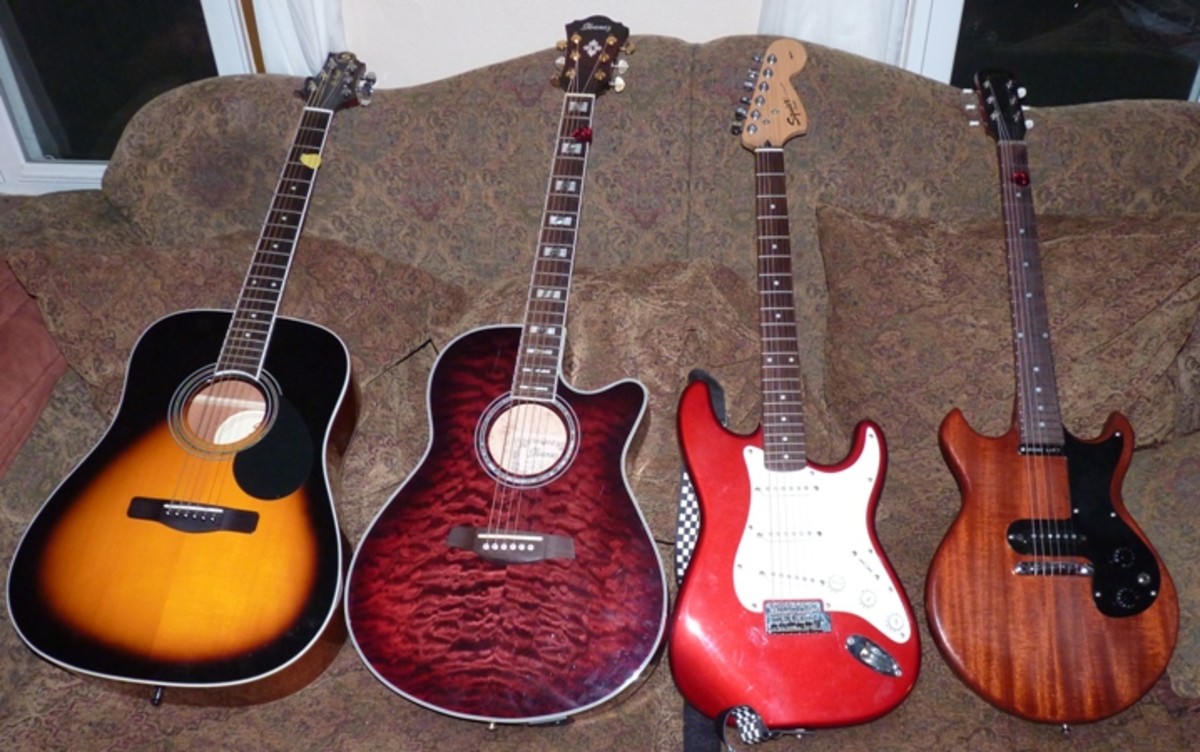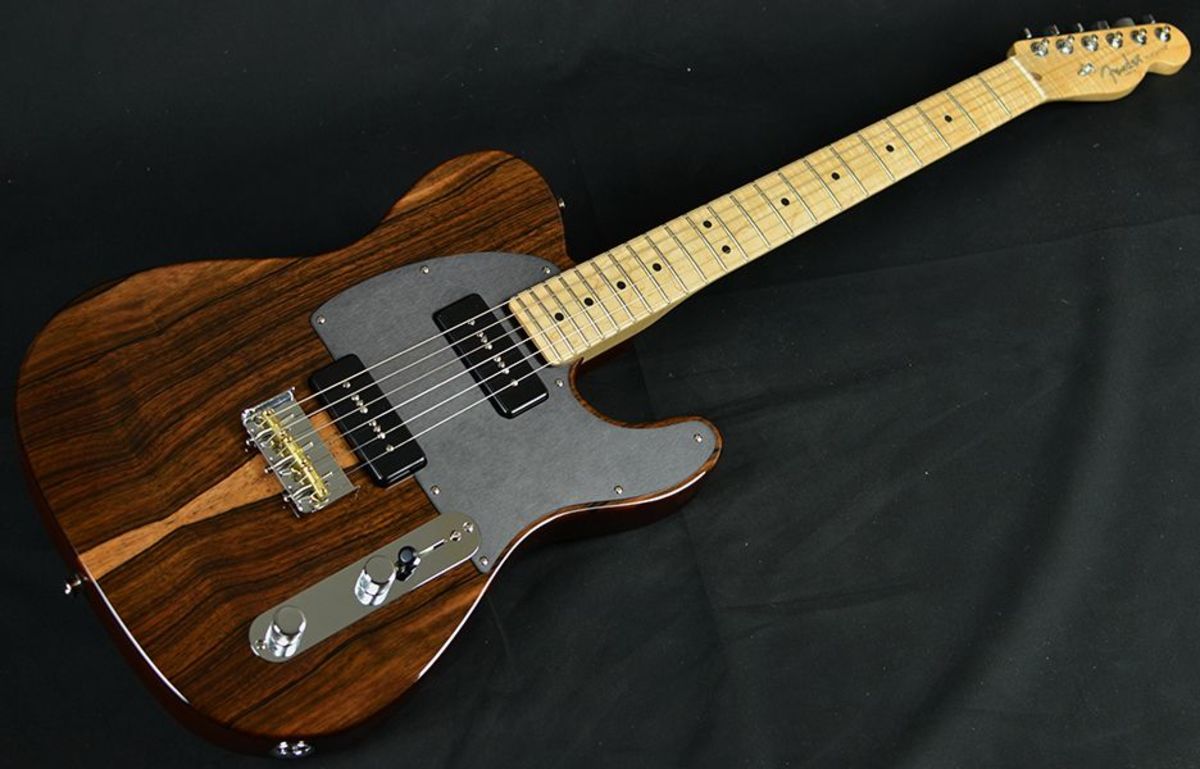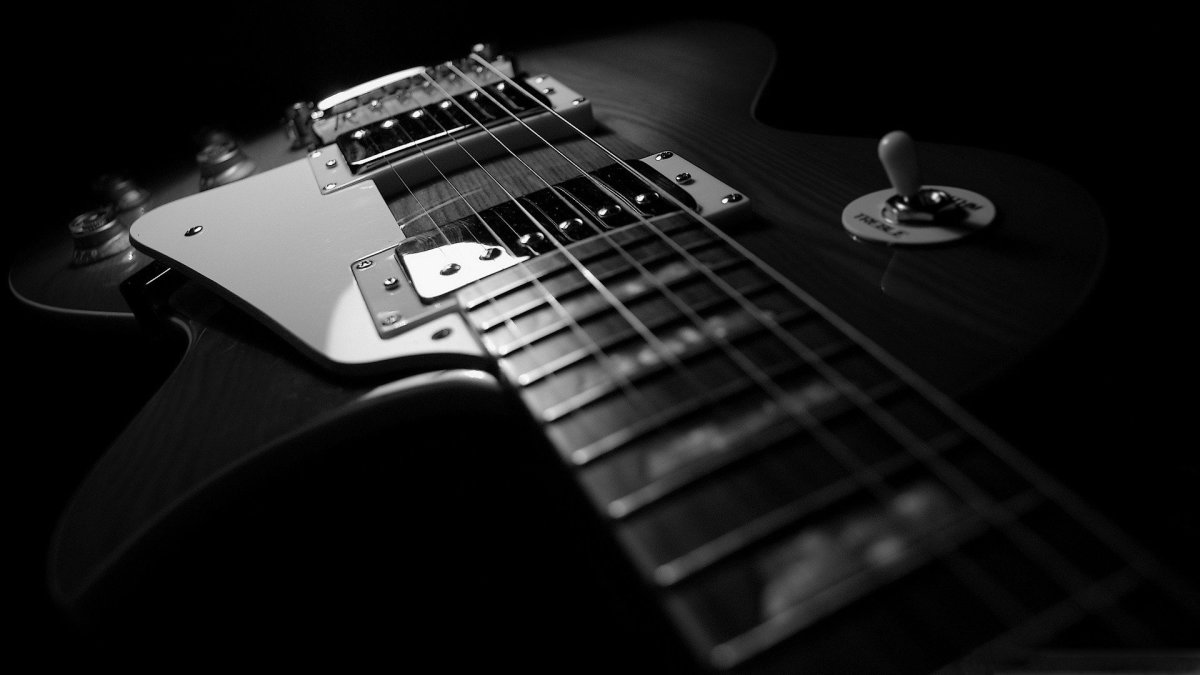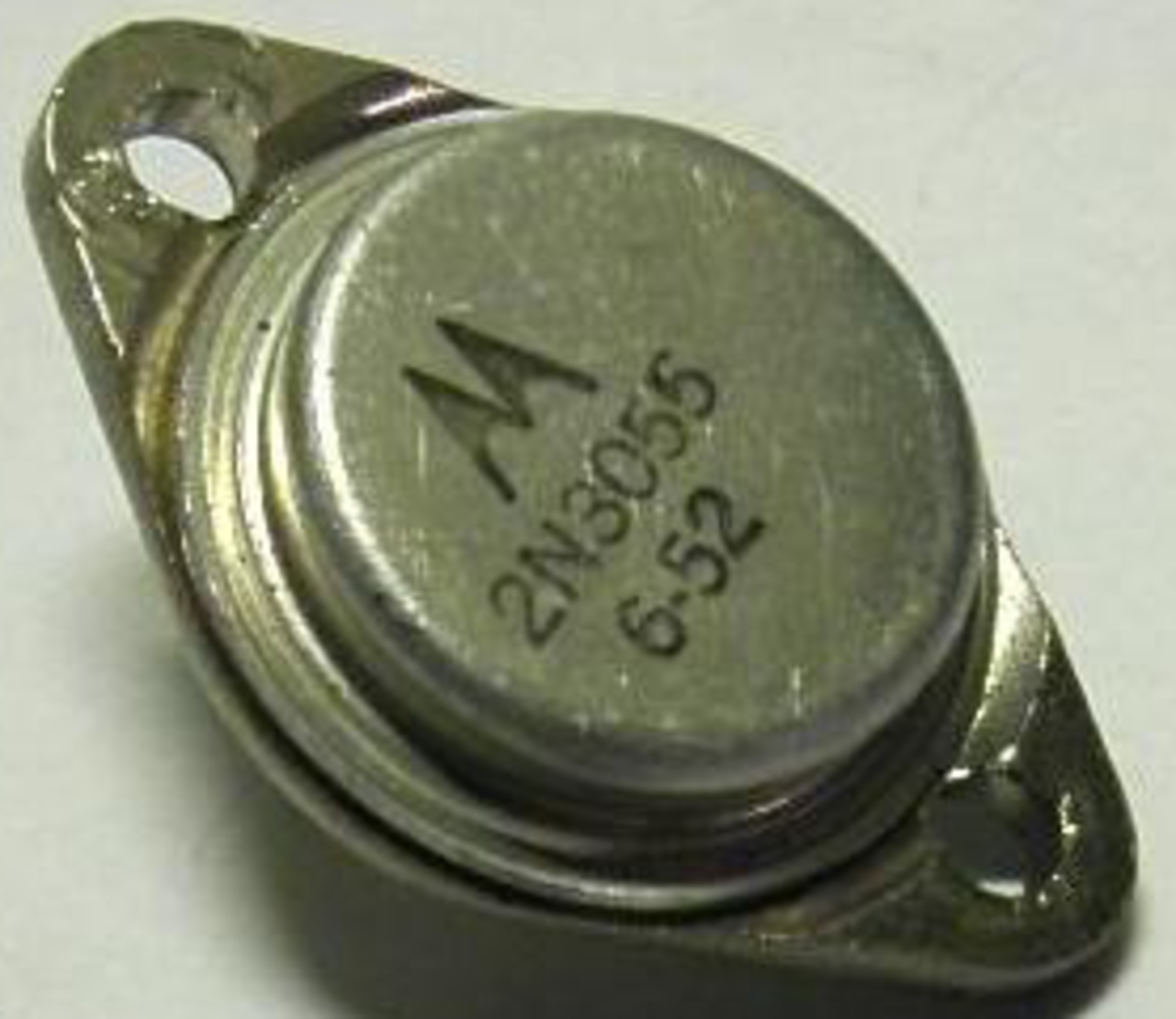Fender, Marshall & Vox: The Heart Of Rock & Roll! -- And Other Amp Stuff.
Some History Behind The Tones...
TONE SICKNESS...
OK... I admit it... I'm out of the closet... I'm a guitar player obsessed (along with every other guitar player) with TONE! -- You have to have it! It's a drug...It's a sickness, but one that's good for suffering.
The only cures needed are some good old Fender Blackface or tweed magic. A healthy dose of heavy Marshall. Or a painless shot of VOX... ey!
We are a fickle bunch and we like it that way!
Give us TONE or give us... Well, you get the picture.
THE CAMPING SOUNDS...
In the world of electric guitar amplification there are two camps: The American camp and the British camp.
Sounds like an alliance. Doesn't it?
Nevertheless, it's true. Most major amplifier manufacturers of the past 50 years have set up residence in one of these two camps.
Here in America, the camp master was Leo Fender. While across the pond, Jim Marshall and the colonels of VOX held reign.
The majority of current electric guitar manufacturers base their mainstay designs (in some variation), on this grouping of hall-of-fame amplifier designers. The various models these companies have produced over the years have literally shaped the sound of modern music as we know it.
From the shimmering brilliance of the Motown sound to the deep, thick tones of the first and second British invasions, thousands upon thousands of records have spun with the tone of these nameplate amplifiers.
Even though it may sound simplistic, the tone palate created by the Fender, Marshall, and VOX sound boils down to three basic principles: Preamp gain, Power amp gain, and Tube type.
So, in order to make a knowledgeable decision in choosing your next electric guitar amplifier, it's a good idea to understand these three, not-so-technical terms.
Gotta Have The Tone...
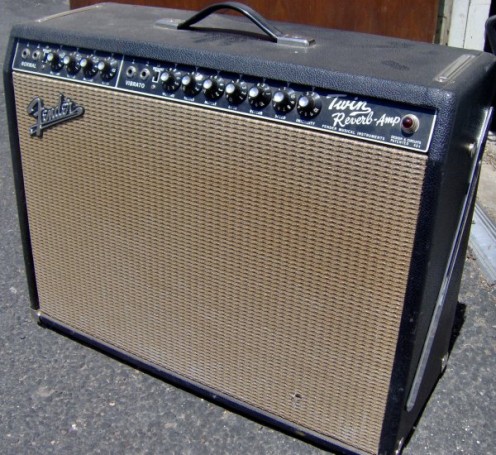
Experience The 1967 Twin Reverb In Action! These Amps Are COOL!
Here Little Tweed...y!
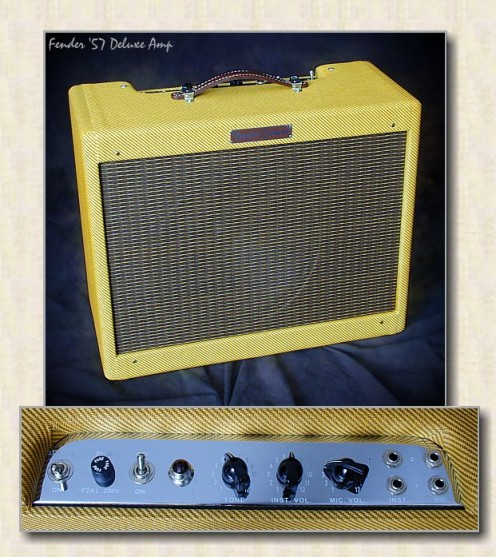
A trio of Fender Tweeds demonstrated by a guy who can PLAY!
Current Amp Manufacturers In The Fender Camp:
- Victoria Amp Works: Beautiful tweed reproductions with tone for days... www.victoriaamp.com
- Allen Amplification: David Allen is making the BEST Fender Blackface-inspired amps in production today. www.allenamps.com
- Carr Amplification: Very nice 6V6 driven tone monsters. www.carramps.com
- Rivera: Paul Rivera (former Fender employee) keeps cranking out the tone after all these years. www.riveraamps.com
PREAMP GAIN:
A preamplifier converts low-level electrical signals into line-level signals.
A line-level signal is a low-voltage, electrical current necessary for the power amp section of an amplifier to properly "gain" or amplify the sound.
Preamps produce voltage gain, but no current gain; which is what power amps create to produce volume.
In summary, preamps "prepare" the original electrical signal for amplification.
A BRIEF OVERVIEW OF PICKUPS:
In the world of guitar amplifiers, low-level signals are produced by the guitar's pickup(s).
When an electric guitar string is played, it vibrates at a given frequency. Sort of like when we speak, our vocal cords move.
Guitar pickups are an assembly of magnets wired together to convert the various frequencies produced by vibrating strings to low-level electrical signals. -- In short, the pickups are the "voice" of the electric guitar.
There are only three primary types of electric guitar pickups used today: The single coil, The humbucker, and The P-90 (which is basically a higher-powered single coil).
Single coil pickups consist of a group of magnets (one for each string) wired around a single coil. While humbuckers utilize a pair of single coils wired together.
P-90s are single coils with additional windings and therefore higher output voltage.
As far as tone is concerned, single coils tend to be brighter and cleaner while humbuckers hedge toward the darker and crunchier parts of town.
Think of the difference between the Nashville sound (single coils) and Led Zeppelin (humbuckers).
Not the greatest analogy, but you get the point... anyway...
BACK TO THE PREAMP STUFF...
After the guitar's pickups have produced their low-level signals, they're sent out of the guitar (via a cable or remote) and into the ampifier's preamp stage.
A large amount of an amplifier's resulting tone will come from its preamp section. The higher amount of gain (voltage) produced by the preamp directly affects what the power amp converts to current gain, or volume.
Here's a brief note to remember: Lower preamp signals lead to cleaner and brighter sounding amplifier tones. While higher preamp signals tend to give amplifiers a darker, more-rounded and "crunchier" tone.
Once the preamp has converted the low-level signals from the guitar into line-level signals, it's onto the power amp stage where the real fun begins!
POWER AMP GAIN:
Power amplifiers are the meat of the guitar amplifier.
The power stage of any tube amplifier contains the large tubes used to create output wattage.
Power tubes come in many power capacities and tonal capabilities. And it's the power tube stages in our noted brandnames that have played a pivotal role in setting up our two camps.
The more overall wattage produced by an amplifier's power tube stage determines the "clean" headroom of an amplifier. In other words, the volume you can crank an amp up to before it starts to breakup.
A simple way to sum up power amp gain is this. The more an amp has (thus the more overall output capacity), the later the amp will distort; and vice versa.
Once the output gain is determined (by how much master volume is dialed in on the amp's front control panel), the signal is then sent the to speaker(s); which are the voice of the amplifier.
A quick note: How much on-stage, lower-volume distortion you desire is a key point in choosing the overall wattage of an electric guitar amp.
If you want a medium-volume amp with a lot of "crunch" to it, a low-watt amp will be your best choice.
On the other hand, if you're playing a huge stadium, you'll probably need more wattage.
In the real world, most guitar players are not playing in front of 30K fans. And from my experience, the lower-watt amps (with a microphone) are just fine.
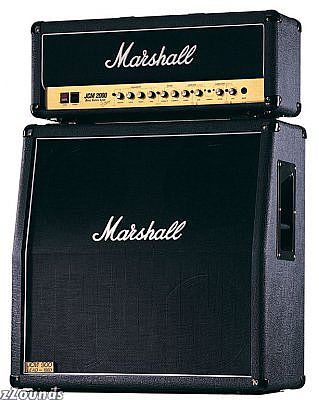
Fender Stratocaster through a Marshall... A darker blues tone, but oh so nice!
Current Manufacturers In The Marshall Camp:
Bogner: These are high gain, channel-switching beasts that refuse to be tamed. Check them out at: www.bogneramplification.com
Fargen: Another boutique amp manufacturer cut out of the Marshall cloth. Visit their site at: www.fargenamps.com
Hiwatt: Made famous by Pete Townshend of the Who, Hiwatt amps are just that: Loud and full of watts. A much brighter Marshall-esque tone using the EL34 power section.
Orange: One of the earlier British-style high gain amps in the Marshall vein, Orange amps found a somewhat cultic following that continues today. www.orangeamps.com
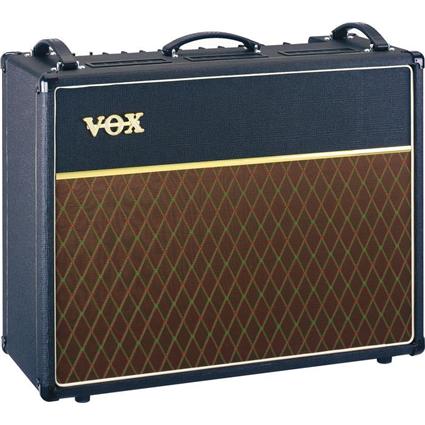
Preamplifier Tube Types:
Preamp tubes are the initial tube stage your guitar signal will hit; which is why the quality of these tubes is so important.
I won't go into great detail about tube quality, but my take is this. Look for NOS (New Old Stock) tubes first.
NOS tubes are those produced by companies such as GE, RCA, Mullard, Telefunken, Sylvania, or Tung Sol but were never sold due to lowered demand. (The days of solid state electronics had begun).
If NOS tubes are too expensive, do your research on current brands. There are still quite a few current production guitar tubes being made; most of which come from China and former Soviet Union states.
Personally, I've had nothing but positive results from buying the NOS tubes. I don't mind paying the higher price because, as I said earlier, TONE is a drug we seek!
Some of the most popular preamp tubes found in guitar amplifiers are:
- 12AT7/ ECC81 (Low voltage)
- 12AU7/ECC82 (Medium Voltage)
- 12AX7/ ECC83 (High Voltage)
Power Tube Types:
Power amp tubes are similar to preamp tubes in how they are bought (NOS vs. current production) but the variance in wattage output is what separates the amplifiers into their camps.
I'll begin by listing the common power tubes used in each camp.
The American Camp: AKA The Fender Camp:
The most popular power tubes found in almost every Fender-type amplifier are as follows.
6V6 & Variations:
6V6GT, 6V6GT-STR, or the 6V6S: These are the tubes that powered the earliest Fender amps heard on every major recording of the 1950s and 1960s. They are simply a fantastic-sounding tube!
The power output of the typical 6V6 tube type is between 8-12 watts.
I personally love 6V6 tubes as they are bright, clean, warm, and break up with a perfect blend of warmth and crunch. Very Nice!
6L6/5881 & Variations:
6L6GC, 6L6GC-STR, or the 6L6 WXT. The 6L6/5881 tube became popular when a bigger, deeper, and more powerful sound was needed.
These tubes were used in the larger Fender amps of the mid to late 1960s and beyond. And they offered a deeper frequency response than 6V6s.
Power output for typical 6L6 type tubes is between 18-25 watts.
The British Camp: AKA Marshall & VOX:
Since it came first, I'll begin by explaining the VOX sound of the first British invasion.
Groups such as the Beatles, The Rolling Stones, and others epitomized the VOX sound.
VOX was one of the first amplifier manufacturers to implement the EL84 type tube; a bright, medium-powered tube with a voice all its own: Very throaty, yet with the capability to sting with the best of them.
Some of the more popular EL84/6BQ5 type tubes are as follows.
- EL84 STM
- EL84/6BQ5
- EL84M
The EL84 tube type is slightly higher-powered than the 6V6, but less than the 6L6. The beauty of this tube is its range of tone and very smooth breakup.
My current amplifier utilizes an EL84 power section and I LOVE them. I have plenty of volume along with heaps of mid-range crunchies. Once again, Very Nice!
Heading into Marshall land:
I think most people, if you asked them to name an electric guitar amplifier brand, would say the name Marshall.
The Marshall stack, as it's been forged in fame, has been (and continues to be) one of the most powerful, and recognizable sounds in all of rock music.
The list of guitar players (and bands) that have used Marshall Amplification is long and storied. But some of the greatest names most people recognize would be the following.
- Jimmi Page/ Led Zeppelin
- Jimi Hendrix
- Alex Lifeson/ Rush
- Peter Frampton
- Slash/ Guns n' Roses
- And a SLEW of others...
The Marshall sound has been forged into the stuff of legend. And the power tubes coming along for the ride are the EL34 tube type.
Some of the more popular EL34 type tubes are.
- EL34B
- EL34 RFT
- 6CA7
- KT77
Most EL34 type tubes are known for their high output, rich mid-range breakup, and power. The EL34 type tube is not as clean as the any of the above-mentioned tubes. But if you're after the king of crunch, this is the tube type to get.
Most EL34 type tubes are rated between 20-30 watts. Very loud tubes for sure!
Current Manufacturers In The VOX Camp:
Matchless: When these amps came out in the early 1990s, they took the recording and live perfromance crowd by storm. Intense tone and built like tanks. Recently re-invented and living tonefully! www.matchlessamplifiers.com
Dr.Z: Mike Zaite's amps are mainstays in almost every recording studio in Nashville, TN and beyond; and for good reason, they rock! www.drzamps.com
Top Hat: Forged in the classic EL84 power tube vein, Top Hat amps are... top hat! www.tophatamps.com
Bad Cat: These amps live up to their name! www.badcatamps.com
A BRIEF SUMMARY:
Although this is just a brief overview of what I feel are the three greatest electric guitar manufacturers of the last 50 plus years, much, much more can be written.
If I were choosing an amplifier, the first thing I'd do is think of what I'll be using it for and what type(s) of guitar(s) I'll be playing through it.
For recording purposes, low-wattage amps are great. You can crank them at lower volumes and still get plenty of power-tube grind.
For gigging purposes, in small to medium-sized venues, an amp with 20-30 watts is usually sufficient (although you'll probably want to mic it).
And for those lucky enough to be playing the arenas, you can buy whatever you want because you won't be carrying it around anyway...
But seriously though, larger venues are where your bigger, 100 watt plus amps will come into play.
To get these larger amps to where they come alive requires plenty of space to handle the 120 dB levels they're capable of producing!
Play ON! I welcome all comments!
Blessings,
RJ

